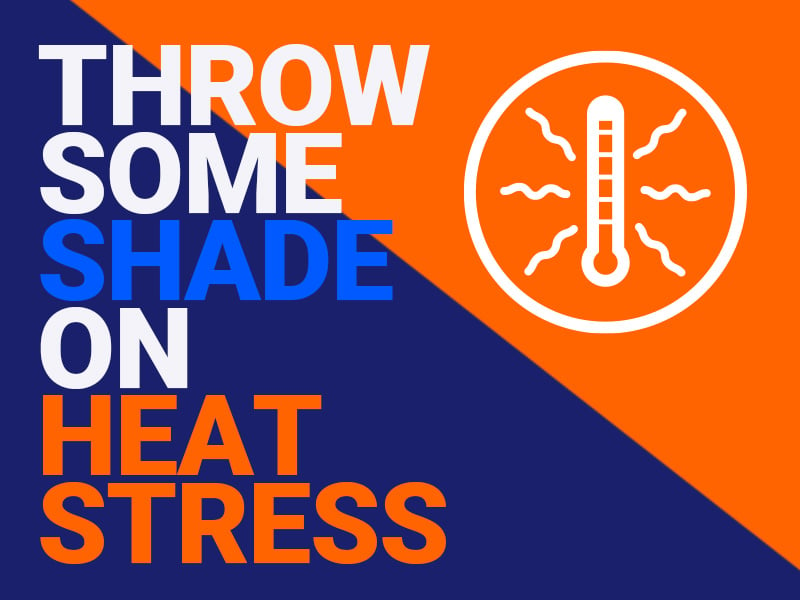It’s that time of year again—the sun’s shining and temperatures are rising. People venture out and spend more time outdoors. It’s the same for construction workers, as companies take advantage of longer days. It's important to provide workers with the tools they need to protect themselves from the hot weather hazards found on construction sites.
Let’s take a look at common construction site hazards that are present during the summer months
Sun Exposure
Working on a construction site in the summer means exposure to the sun. It’s important to protect against the harmful ultraviolet (UV) radiation that can cause damage to your skin and eyes. Sun exposure can prematurely age the skin. It can also cause cataracts to form and skin cancer to develop.
It's important to take precautions and protect against harmful UV rays. There are many ways that you can protect yourself, even if you can’t avoid working during peak hours (10 a.m. to 4 p.m.).
- Use sunscreen (at least SPF 15) and apply it according to the instructions on the bottle
- Wear protective headgear, such as a hat with a wide brim that gives shade to your neck, ears and face
- Cover your body with tightly-woven clothes that block light
- Wear sunglasses that block UVA and UVB radiation
Poisonous Plants
Spring and summer are peak growing seasons for poisonous plants. About 85 percent of people will have allergic reactions to poison ivy, poison oak or poison sumac. Reactions usually occur within 24 to 72 hours of exposure. The symptoms of a reaction to poisonous plants are similar to an itchy rash, but also have reddish bumps and red streaks around the point of contact.
Construction sites near grassy, weed-infested areas are breeding grounds for poisonous plants. Train employees on how to identify poisonous plants that they might encounter. Encourage them to wear long-sleeved shirts and long pants tucked into boots. Gloves will help avoid direct contact with these plants. If an employee comes into contact with these plants, it is important to act quickly to minimize the reaction.
- Thoroughly rinse any exposed clothing and then wash with a detergent to remove plant oils
- Keep isopropyl alcohol on site to clean the sap from tools and other items
- If the sap touches the skin, wash the exposed area with cleanser as soon as possible
If an employee does have an allergic reaction, over-the-counter soaks and gels can be used to relieve symptoms and reduce the urge to scratch (which only spreads the infection).
Bug Bites
With plants come bugs, especially bees, ticks and mosquitoes. Make sure your employees know all about the dangers of bug bites and how to protect themselves.
- Ticks can transmit Lyme disease, which often involves a “bulls-eye” rash (around the bite mark) with some flu-like symptoms
- Ticks can also spread Rocky Mountain Spotted Fever, which comes with fever, headaches and muscle aches. Blackened, crusty skin around at the site of the tick bite is also common
- Mosquitoes are carriers of West Nile Virus, which causes fever, headaches, body aches and occasionally a rash. The symptoms of West Nile Virus can grow more severe and lead to tremors, convulsions and even coma
Construction workers should be trained to identify the symptoms of these bug-borne illnesses and how to prevent them:
- Wear proper clothing when working outside (light colors let you see ticks when they attach to your clothes)
- Tuck pants into your socks or boots and wear closed-toe shoes
- Use tick bug repellent with DEET on your clothes (avoid contact with skin)
- Shower after work, examine your body for ticks, wash clothes in hot water and dry them in high heat
- Wear a hat
Aches and Pains
Summertime means more work for the construction industry. Working construction is always tough on the body, but longer hours on the jobsite can take a toll. From muscle cramps to sprains and strains, workers need to take extra precautions to care for their bodies:
- Try to hit the gym or take a walk to keep muscles loose
- Drink plenty of fluids to keep hydrated and avoid muscle cramping
- If you use tobacco, quit or cut back as much as possible
- Take extra care to eat healthy. Lighter meals during the high points of the day will help your body handle the extra stress

Summer Safety on Construction Sites
Heatstroke is a very serious concern for construction workers, but site managers should also address the many other outdoor hazards on construction sites. Make sure that everyone on the jobsite knows how to identify and protect against these additional hazards. It not only keeps workers safe, but increases productivity.








